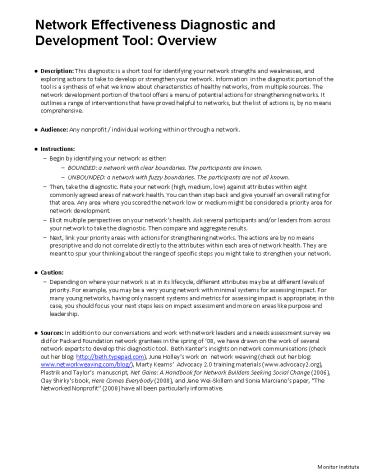Network Effectiveness Diagnostic and Development Tool: Overview - PowerPoint PPT Presentation
1 / 5
Title:
Network Effectiveness Diagnostic and Development Tool: Overview
Description:
The network development portion of the tool offers a menu of potential actions ... out her blog: http://beth.typepad.com), June Holley's work on network weaving ... – PowerPoint PPT presentation
Number of Views:33
Avg rating:3.0/5.0
Title: Network Effectiveness Diagnostic and Development Tool: Overview
1
Network Effectiveness Diagnostic and Development
Tool Overview
- Description This diagnostic is a short tool for
identifying your network strengths and
weaknesses, and exploring actions to take to
develop or strengthen your network. Information
in the diagnostic portion of the tool is a
synthesis of what we know about characteristics
of healthy networks, from multiple sources. The
network development portion of the tool offers a
menu of potential actions for strengthening
networks. It outlines a range of interventions
that have proved helpful to networks, but the
list of actions is, by no means comprehensive. - Audience Any nonprofit / individual working
within or through a network. - Instructions
- Begin by identifying your network as either
- BOUNDED a network with clear boundaries. The
participants are known. - UNBOUNDED a network with fuzzy boundaries. The
participants are not all known. - Then, take the diagnostic. Rate your network
(high, medium, low) against attributes within
eight commonly agreed areas of network health.
You can then step back and give yourself an
overall rating for that area. Any area where you
scored the network low or medium might be
considered a priority area for network
development. - Elicit multiple perspectives on your networks
health. Ask several participants and/or leaders
from across your network to take the diagnostic.
Then compare and aggregate results. - Next, link your priority areas with actions for
strengthening networks. The actions are by no
means prescriptive and do not correlate directly
to the attributes within each area of network
health. They are meant to spur your thinking
about the range of specific steps you might take
to strengthen your network. - Caution
- Depending on where your network is at in its
lifecycle, different attributes may be at
different levels of priority. For example, you
may be a very young network with minimal systems
for assessing impact. For many young networks,
having only nascent systems and metrics for
assessing impact is appropriate in this case,
you should focus your next steps less on impact
assessment and more on areas like purpose and
leadership. - Sources In addition to our conversations and
work with network leaders and a needs assessment
survey we did for Packard Foundation network
grantees in the spring of 08, we have drawn on
the work of several network experts to develop
this diagnostic tool. Beth Kanters insights on
network communications (check out her blog
http//beth.typepad.com), June Holleys work on
network weaving (check out her blog
www.networkweaving.com/blog/), Marty Kearns
Advocacy 2.0 training materials
(www.advocacy2.org), Plastrik and Taylors
manuscript, Net Gains A Handbook for Network
Builders Seeking Social Change (2006), Clay
Shirkys book, Here Comes Everybody (2008), and
Jane Wei-Skillern and Sonia Marcianos paper,
The Networked Nonprofit (2008) have all been
particularly informative.
2
Diagnostic Tool for Bounded Networks
3
Development Tool for Bounded Networks
4
Diagnostic Tool for Unbounded Networks
5
Development Tool for Unbounded Networks































